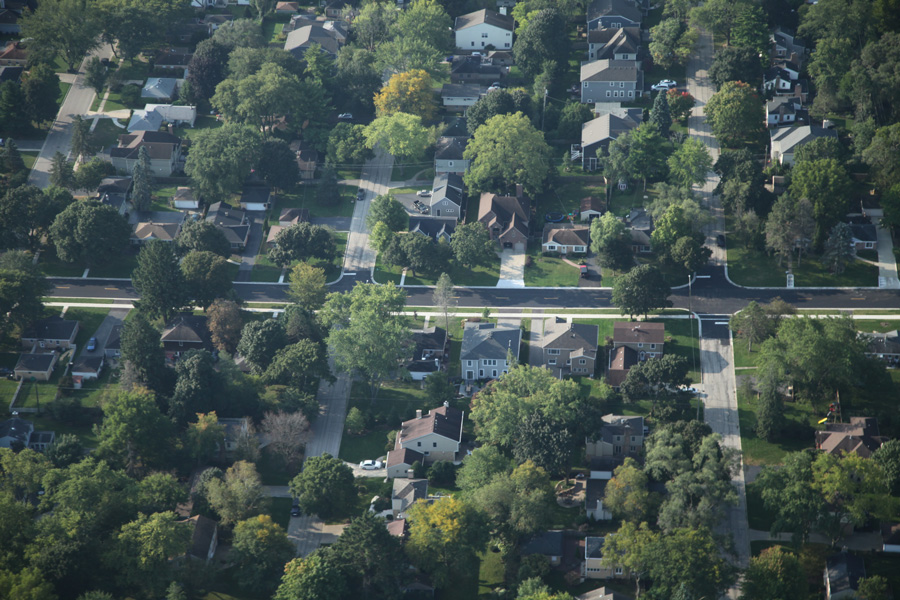
On Tuesday, March 2, Civiltech’s Rockland Road Improvement Project was awarded the APWA Lake Branch Project of the Year in the Transportation/$5M to $25M category. The project was nominated by our clients, the Village of Libertyville and the Libertyville Township Road District.
A Project Built on Collaboration
Through collaboration and coordination, the Village and the Township teamed up to undertake a substantial and critical corridor improvement. Working together, they reconstructed 1.4 miles of Rockland Road between IL Route 21 (Milwaukee Avenue) and St. Mary’s Road. The Des Plaines River lies at the approximate midpoint of the project, with the Village jurisdiction to the west and the Township jurisdiction to the east. With the separate jurisdictions, the project was divided into two contracts. However, it was coordinated and managed as one project the length of the corridor.
Careful collaboration between the Village and the Township, combined with strategic scheduling, resulted in minimizing the impact of this substantial improvement to the motoring public. Construction coordination and careful timing of the complex construction operations were critical. The Village side of the improvement was let first as it involved extensive underground utility improvements needed before the roadway construction along the entire corridor could proceed. Traffic control throughout all construction activities the length of the improvement needed to be treated as one project.
Civiltech provided a Phase I study, Phase II Design Engineering, and Phase III Construction Engineering on the project and helped both agencies secure STP funding. Reconstruction of the bridge was not included, but is now a separate Phase I study currently underway by Civiltech.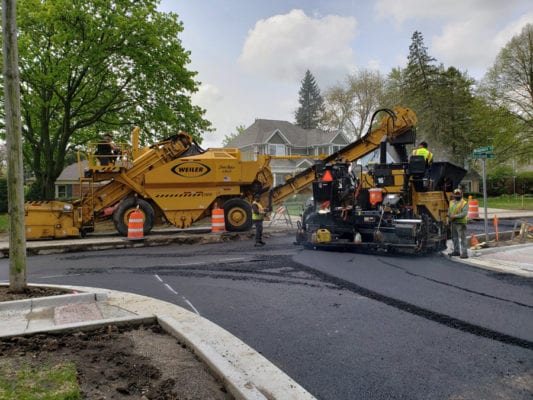
Rockland Road is a two-lane major collector street that carries approximately 6,000 vehicles per day and is signalized at the west and east terminus intersections. The Village jurisdiction is an urban cross-section with curb and gutter and an enclosed drainage system. Resurfacing projects over the past few decades have resulted in the concrete gutter being overlaid resulting in only an inch or two of curb height remaining. Therefore, the roadway was reconstructed in place as the pavement had reached the end of its design life. A new storm sewer trunk line was included in the project to drain the roadway and to provide relief for a residential stormwater flooding problem toward the west end of the project. During the design the Village completed a flood relief study that recommended upsizing the 48” storm sewer to 84” that outlets into the Des Plaines River. In addition, the project replaced an aging water main trunk line.
Within the Township jurisdiction, the existing roadway is a tree-lined 24-foot paved rural cross section drained by open ditches and swales which had also reached the end of its design life. The Phase I study identified a need for improved pedestrian and bicycle facilities to provide access to the Des Plaines River Trail. Therefore, the Township chose to include 2-foot paved shoulders as part of the proposed improvement.
The projects have achieved all of their intended goals by providing a newly constructed roadway which is safe for motorists and pedestrians. The risk of reoccurring flooding that was previously experienced within the adjacent neighborhoods has been significantly reduced, as runoff now has the ability to pass through the huge new drainage system before ultimately being dispersed as a slow and clean stream into the Des Plaines River.
Critical Construction Management Techniques
Working within two jurisdictions and with two separate prime contractors combined with the installation of a massive 84” diameter storm sewer pipe down the center of Rockland Road on the Village side of the projects presented unique challenges requiring outstanding construction management techniques. Civiltech assigned a senior Resident Engineer to provide overall communication and coordination between the two projects. Then, two Assistant Resident Engineers were each assigned to the separate projects. This creative approach ensured that both projects were completed on schedule since potential conflicts were carefully coordinated. Also, this unifying tactic successfully managed the following unique and significant construction challenges:
Coordination of Contractors: The project involved two separate prime contractors and traffic control subcontractors. With both projects being constructed simultaneously, the teams had to work as if the two separate contracts were one single project.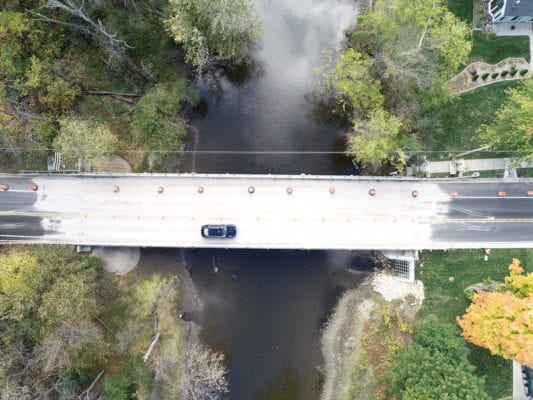
Maintenance of Traffic: Traffic control was critical to not only keeping traffic moving safely through the tight space around the extensive excavations on the Village side and maintaining a safe work zone, but to ensure that traffic movement and detours were coordinated and made sense for the length of the corridor in both jurisdictions. Timing was everything when it came to ensuring that both contractors completed their work in each MOT stage prior to switching.
Critical Stakeholder Coordination: The R.E.’s had to coordinate with natural gas main relocation contractors along the corridor to avoid potential conflicts. Also, due to the extensive excavation requirements, homeowners were greatly impacted and required active communication and timely notification.
A primary construction management challenge on the Village side of the improvement was managing the “running sand” conditions in the deep excavations required for the installation of the 84” storm sewer pipe. With the proximity to the Des Plaines River, a high water table, a soil content of porous sand, and an extremely deep excavation requirement, water poured into the excavations faster than it could be pumped out.
To allow construction to move forward, cofferdams had to be built across the excavation allowing areas to be pumped dry enough to provide a section for pipe placement. Then the cofferdam had to be quickly moved forward along the line of the new storm sewer pipe installation in a staged construction sequence with the pumping following along behind the cofferdams. This technique had to be carefully coordinated to control the extensive running sand water intake and to keep the project moving forward.
Safety Programs during Construction
The location of this project adjacent to the Des Plaines River created unique situations requiring carefully planned safety programs.
Bridge Pedestrian Access: The bridge, which crosses the Des Plaines River and connects the two roadway sections, had required modification prior to the Rockland Road work due to structural conditions that had become unsafe. A truss had been erected over the bridge many years ago that did not provide any support to the roadway, but did include the structure supporting the sidewalk. The truss had to be removed which left the bridge with no pedestrian facility. While the bridge connected the two legs of Rockland Road and all associated pedestrian and bicycle travel, it also provided access to the Des Plaines River Trail on the Township side of the river. Therefore, a safe pedestrian facility had to be added to the bridge and maintained through construction and beyond. To accomplish this, temporary barrier walls were installed on the bridge to create a walking path.
Braced Excavations: As described in the previous section, the “running sand” was a significant challenge in the large excavations required for the 84 inch storm sewer pipe installation and associated junction chambers. To manage the coffered dams, pumping, excavation work, and construction work, braced excavations had to not only be appropriately substantial but also strong enough to acquire the needed depth. Cave-ins were a potential danger which could affect worker’s safety and neighboring property damage. The bracing had be designed and the activity coordinated such that they could be quickly and safely installed, relocated, and removed.
COVID-19 Safety: With construction activities deemed essential business, construction of these projects progressed through the spring and summer of COVID restrictions. Libertyville, the Township, and Civiltech took proactive and aggressive COVID safety precautions for field staff. The agencies’ staff and RE’s involved in the project worked to ensure that social distancing could be maintained despite the many workers on the project. Civiltech provided Personal Protective Equipment (PPE) and their RE’s utilized their individual vehicles as construction site offices. The Rockland Road projects were completed without any resulting COVID cases.
Community Relations
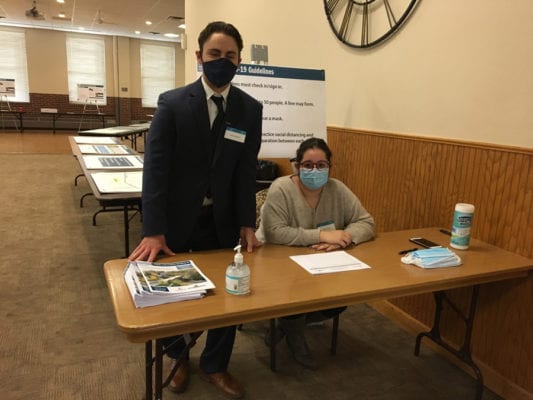 Community relations were a critical component of Civiltech’s Construction Engineering services. On the Village side, the massive excavations required to install the new 84” storm sewer created a tremendous inconvenience to homeowners along the project limits. Homeowner’s driveways could be blocked for as long as a period of 3 weeks while the sanitary sewer and watermain work was being done. Planning involved providing parking locations for the displaced homeowners and the installation of temporary sidewalks. In addition to homeowners, a large business park is located within the project limits, with their critical entrance near the bridge. Communication and coordination was crucial to their business operations.
Community relations were a critical component of Civiltech’s Construction Engineering services. On the Village side, the massive excavations required to install the new 84” storm sewer created a tremendous inconvenience to homeowners along the project limits. Homeowner’s driveways could be blocked for as long as a period of 3 weeks while the sanitary sewer and watermain work was being done. Planning involved providing parking locations for the displaced homeowners and the installation of temporary sidewalks. In addition to homeowners, a large business park is located within the project limits, with their critical entrance near the bridge. Communication and coordination was crucial to their business operations.
Also, the community had many concerns regarding the project. The Village, Township, and Civiltech together had hosted a number of public meetings during Phase I where these concerns had been communicated. The topics of the meetings not only regarded the inconveniences during the actual construction, but also the size of the proposed drainage improvements and future plans for the bridge. The Rockland Team engaged in proactive and impactful community relations. A project website was established representing both projects. Not only did the site provide construction updates and scheduling information for the public, but it allowed community members to ask questions and express concerns. Civiltech did not let those questions and concerns die on the website, but ensured that all comments and questions were addressed and answered.
In addition to the website, Civiltech’s Resident Engineer’s took a very hands-on approach to direct communication with the neighbors. The R.E.’s proactively ensured that neighbors were aware of forthcoming impacts to their property, and the R.E.’s made themselves available to directly answer neighbors’ questions. This resulted in fewer questions elevated to Libertyville and the Township.
Protecting the Environment
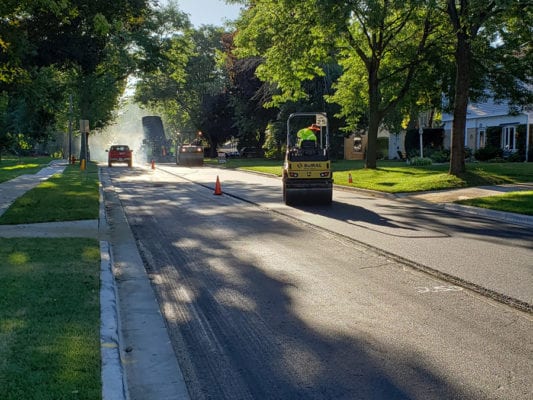 These projects involved tremendous environmental considerations due their proximity and impact to the Des Plaines River and the type of work being performed. As with any project adjacent to a waterway, minimizing disturbances and preventing erosion are critical. Civiltech’s river protection plans were part of the Phase II Design Engineering in addition to being administered by our Resident Engineers.
These projects involved tremendous environmental considerations due their proximity and impact to the Des Plaines River and the type of work being performed. As with any project adjacent to a waterway, minimizing disturbances and preventing erosion are critical. Civiltech’s river protection plans were part of the Phase II Design Engineering in addition to being administered by our Resident Engineers.
To mitigate disturbances, areas affected by construction were immediately repaired with seeding or plantings to prevent erosion. Additionally, erosion dams were installed during work on the storm sewer to protect the river.
An additional challenge was created by the pumping activities in the storm sewer excavations. Due to the sand infused subsoil, water that was intended to be pumped from the excavations and returned to the river contained excessive amounts of silt. To mitigate this, the water was pumped through silt bags to capture the silt prior to the water returning to the river. Also, the silt infused water was pumped through a fluid diversion mechanism attached in line with the piping, which introduces polymers to reduce turbidity and improve water quality. For guidance to ensure that the measures were appropriate and effective, Civiltech coordinated with the Lake County Storm Water Management Commission.
Accomplishments under Adverse Conditions
Unusual accomplishments under adverse conditions were abundant on this project. Adverse conditions, including site conditions, soil conditions, adverse weather, and existing utility locations requiring creative solutions from the project team.
The groundwater table was at the invert elevation of the 84” storm sewer pipe installation creating the running sand condition described above. A deep-well bypass pumping operation was employed to allow the installation of the large pipes and accompanying structures onto a stable base. Additionally, the storm sewer installation and pumping operations became challenging as the Des Plaines River elevation rose above the invert elevation with most rain events. The pumping operations and staging of the protective coffered dams allowed the project to proceed despite these adverse conditions.
Existing sanitary sewer and water lines servicing residences along the Village portion of the project crossed under the street perpendicular to the designed layout of the new storm sewer. With the 84” diameter of the storm sewer, it was critical to ensure that the sanitary lines could pass over the new storm sewer and that the sanitary main would not be undermined or collapse.
Precast concrete junction chambers were installed with each chamber weighing approximately 100,000 LBS. The junction chambers were connected by a 48-foot long, 10-foot x 4-foot box culvert. The culvert allowed the flow between the new 84″ diameter storm sewer pipes to run under conflicting sanitary sewer.
Use of alternative materials, practices or funding with a Commitment to sustainability
The project was funded through a combination of federal, motor fuel tax, and local funds. The local funds included funding to upsize the storm sewers. This critical storm sewer management which included the new upsized storm sewer and moving stormwater through the newly installed piping system, as opposed to it directly washing into the river, not only relieves the local flooding, but mitigates further impacts downstream.
